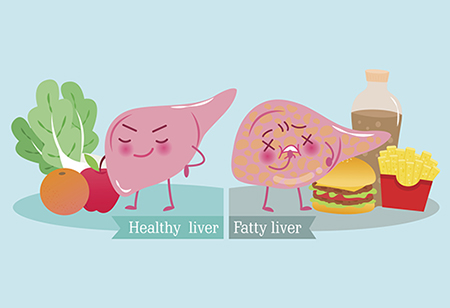Your liver is the largest organ inside your body. It helps your body digest food, store energy, and remove poisons. Fatty liver occurs when too much fat builds up in liver cells. Although it is normal to have a tiny amount of fat in these cells, the liver is considered fatty if more than 5% of it is fat. There are two main types:
- Nonalcoholic fatty liver disease (NAFLD)
- Alcoholic fatty liver disease, also called alcoholic steatohepatitis
Major risk factors for Fatty Liver include obesity, high triglycerides and type 2 diabetes, though it’s also associated with excessive alcohol consumption. Other risk factors include certain medications such as glucocorticoids, and hepatitis C. Eating excess calories causes fat to build up in the liver. When the liver does not process and break down fats as it normally should, too much fat will accumulate. So Diet plays a major role.
Often there are no or few symptoms. Most individuals are asymptomatic and are usually discovered incidentally because of abnormal liver function tests or hepatomegaly noted in unrelated medical conditions. Occasionally there may be tiredness or pain in the upper right side of the abdomen.
Just because simple fatty liver is harmless, it doesn’t mean it is not a serious condition. As the disease is linked to being overweight or obese, people with any stage of the disease are more at risk of developing a stroke or heart attack.
1.Stage/Grade 1: simple fatty liver (steatosis)
This is where excess fat builds up in the liver cells but is considered harmless. There are usually no symptoms and you may not even realise you have it until you receive an abnormal blood test result.
2.Stage/Grade 2: nonalcoholic steatohepatitis
Stage 2 is a more aggressive form of the condition, where the liver has become inflamed.
3.Stage/Grade 3: fibrosis
This fibrous tissue replaces some of the healthy liver tissue, but there is still enough healthy tissue for the liver to continue to function normally.
Prevention & Management-
- It is recommended that people with fatty liver disease do not drink alcohol.
- Treatment of NAFLD is generally otherwise by dietary changes and regular exercise to bring about weight loss. Decreasing caloric intake by at least 30% or by approximately 750–1,000 kcal/day results in improvement in hepatic steatosis. For people with NAFLD, weight loss via a combination of diet and exercise was shown to improve or resolve the disease.
- It is important to make lifestyle changes to prevent the disease progressing to a more serious stage and to lower your risk of having a heart attack or stroke.
- Stop smoking
- Treatment of underlying cause if any.
- Care Towards Cure have treated successfully many patients of Fatty Liver with combination of Best suited Homeopathy Treatment, Dietry – Lifestyle changes & Life coaching.
6 foods to avoid if you have a fatty liver
- Alcohol as Alcohol is a major cause of fatty liver disease as well as other liver diseases.
- Added sugar-Stay away from sugary foods such as candy, cookies, sodas, and fruit juices.
- Fried foods as these are high in fat and calories.
- Salt.
- White bread, rice, and pasta & other Starchy food
- Red meat.
Eat a Balanced diet
- Select foods from all food groups: Grains, fruits, vegetables, meat and beans, milk, and oil.
- Eat food with fiber. Fiber helps your liver work at an optimal level. Fruits, vegetables, whole grain breads, rice and cereals can take care of your body’s fiber needs.

